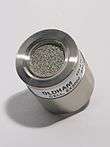Pellistor
A pellistor is a solid-state device[1] used to detect gases which are either combustible or which have a significant difference in thermal conductivity to that of air. The word "pellistor" is a combination of pellet and resistor.
Principle
The detecting element consist of small "pellets" of catalyst loaded ceramic whose resistance changes in the presence of gas. Many of them require to be gently heated in use, so they may be four terminal devices with two connections for a small heating element and two to the sensor itself.

To avoid any risk of explosion, the sensitive element is usually enclosed in a wire mesh housing. More robust sensors for use in high risk environments may have solid steel housing with a gas port of sintered metal granules.[2] Both of these work in a manner similar to the Davy safety lamp; gas may percolate through the permeable mesh, but the passages are too long and narrow to support the propagation of a flame.
History
The pellistor was developed in the early 1960s for use in mining operations as the successor of the flame safety lamp and the canary. It was invented by English scientist Alan Baker. [3]
Types
Catalytic
The catalytic pellistor as used in the catalytic bead sensor works by burning the target gas; the heat generated producing a change in the resistance of the detecting element of the sensor proportional to the gas concentration.
Thermal Conductivity
The thermal conductivity (TC) pellistor works by measuring the change in heat loss (and hence temperature/resistance) of the detecting element in the presence of the target gas.
See also
References
- ↑ Pellistor RSC
- ↑ "Gas detectors" (PDF). Oldham Group.
- ↑ Baker, Alan. "Apparatus for detecting combustible gases having an electrically conductive member enveloped in a refractory material". www.Google.com/Patents.